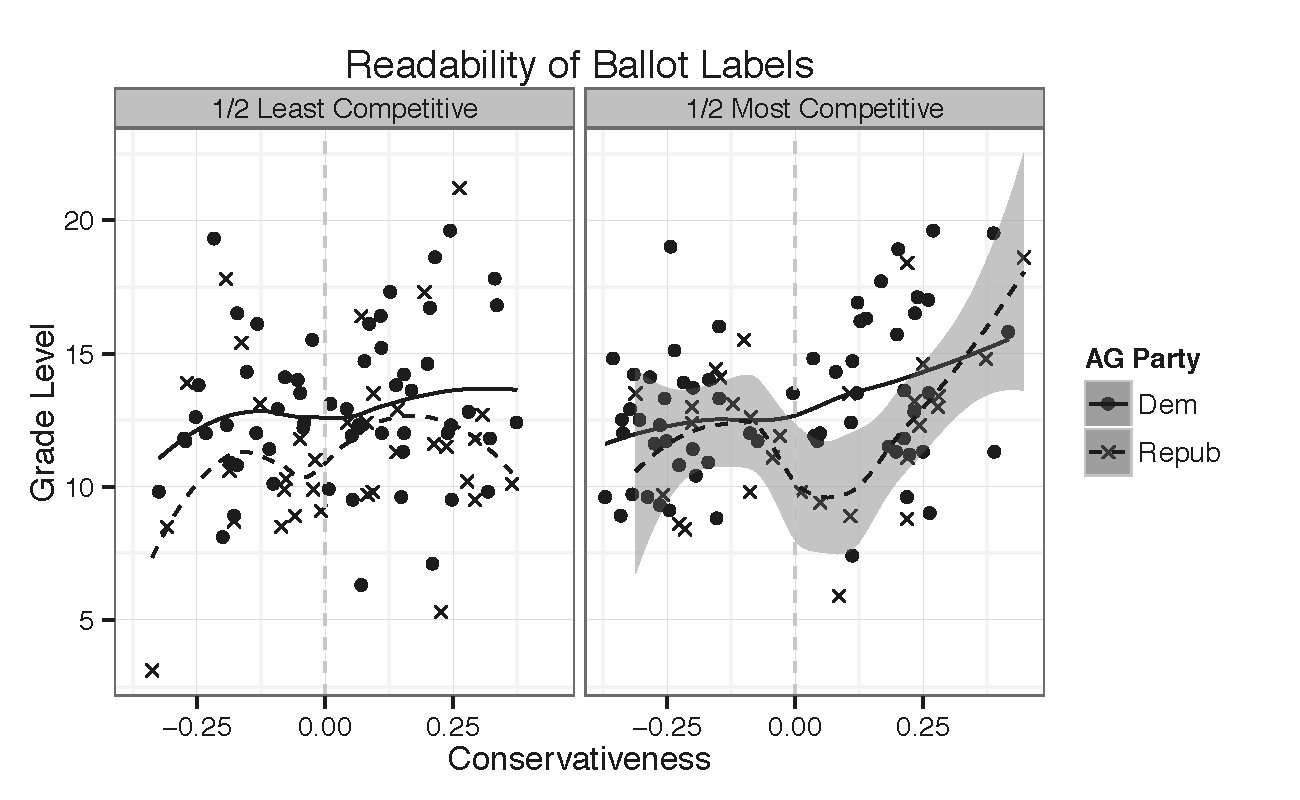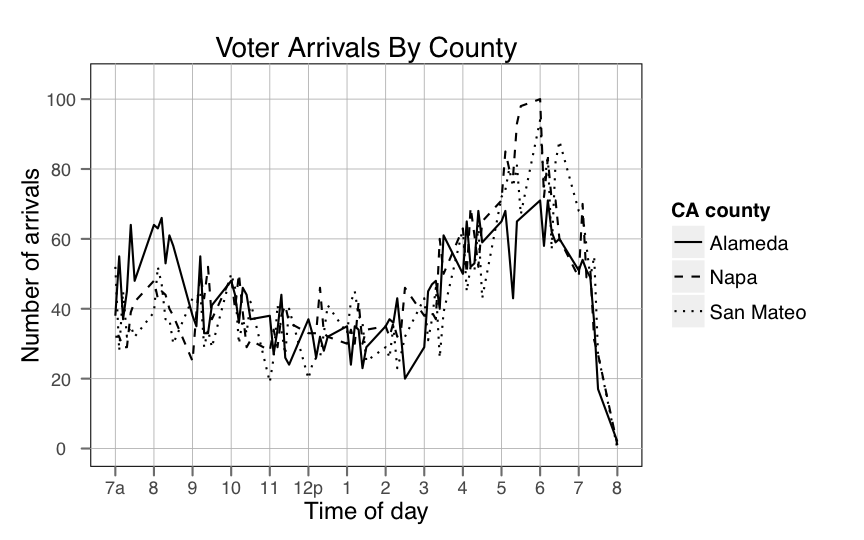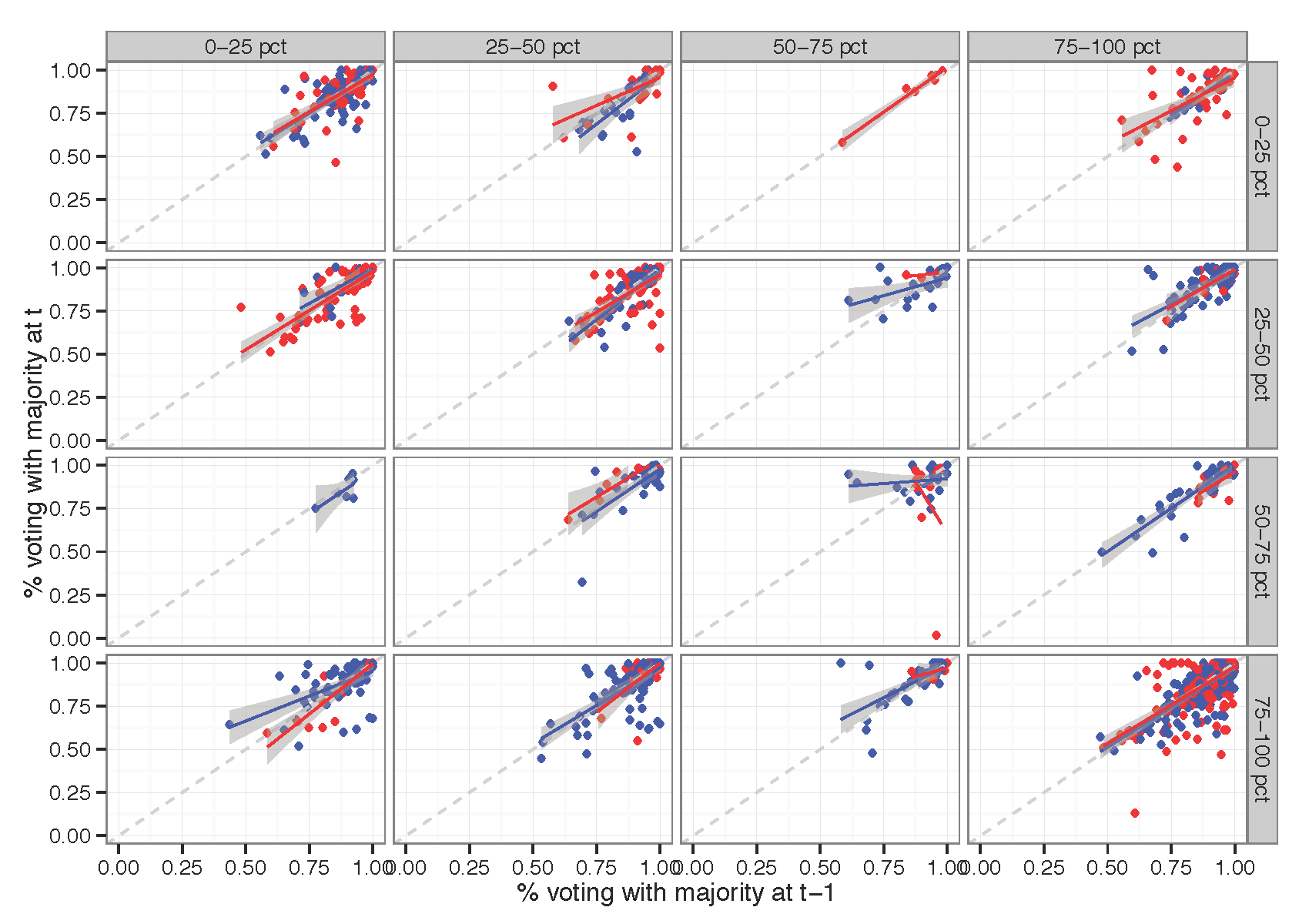Publications
Citizens United, States Divided: An Empirical Analysis of Independent Political Spending
89 Indiana Law Journal ___ (forthcoming 2014) (with Abby K. Wood)
 Abstract |
Paper
Abstract |
Paper
 |
What effect has Citizens United v. FEC had on independent spending in American politics? Previous attempts to answer this question have focused solely on federal elections where there is no baseline for comparing changes in spending behavior. We overcome this limitation by examining the effects of Citizens United as a natural experiment on the states. Before Citizens United about half of the states banned corporate independent expenditures and thus were “treated” by the Supreme Court’s decision, which invalidated these state laws. We rely on recently released state-level data to compare spending in "treated" states to spending in the "control" states that have never banned corporate or union independent expenditures. We find that while independent expenditures increased in both treated and control states between 2006 and 2010, the increase was more than twice as large in the treated states and nearly all of the new money was funneled through nonprofit organizations and political committees where weak disclosure laws and practices protected the anonymity of the spenders. Finally, we observe that the increase in spending after Citizens United was not the product of fewer, larger expenditures as many scholars and pundits predicted, and we note that people were just as likely to make smaller expenditures (less than $400) after Citizens United as they were before. This finding is particularly striking because it cuts against the conventional wisdom of spending behavior and also challenges the logic of those who disagree with the most controversial element of the Citizens United decision – the rejection of political equality as a valid state interest. » Slides (.pdf) · 2012 Law and Society Association Annual Meetings (Honolulu, HI) · 2012 Midwest Political Science Association Annual Meetings (Chicago, IL) |
Are Ballot Titles Biased? Partisanship in California's Supervision of Direct Democracy
3 U.C. Irvine Law Review ___ (forthcoming 2013) (with Christopher S. Elmendorf)
 Abstract |
Paper |
Appendix (Survey Instrument) |
Voter Guide Language (.zip) | Replication data (coming soon)
Abstract |
Paper |
Appendix (Survey Instrument) |
Voter Guide Language (.zip) | Replication data (coming soon)
 |
This study investigates whether and if so under what conditions the California Attorney General, who authors the ballot title and summary ("label") for statewide ballot initiatives, writes ballot language that is biased rather than impartial. State law demands an impartial label, but commentators frequently complain that the AG chooses misleading language to bolster (undermine) measures that the AG or his/her party supports (opposes). Using a convenience sample of students from several universities, we measure ordinary observers’ perceptions of bias in ballot labels for initiatives dating back to 1974. Separately, we calculate an objective measure of bias using a readability algorithm. We then test hypotheses about AG strategy, examining whether the extent of bias in ballot labels varies with the closeness of the election and the degree to which the measure elicits partisan division. We also examine the correlation between bias perceptions and observer characteristics such as support for the ballot measure, trust in government, and social trust. · Invited paper for 2012 Election Law Symposium (UC Irvine) |
Long Lines at Polling Stations? Observations from an Election Day Field Study
9 Election Law Journal 3 (2010) (with Zachary S. Markovits)
 Abstract |
Paper |
Replication data (.zip)
Abstract |
Paper |
Replication data (.zip)
 |
This pilot study represents the first systematic attempt to determine how common lines are on Election Day, at what times of day lines are most likely to form, what are the bottlenecks in the voting process, and how long it takes an average citizen to cast his or her ballot. This study highlights the importance of evaluating polling station operations as a three-step process: arrival, check-in, and casting a ballot. We collected data during the 2008 presidential primary election in California, measuring the efficiency of the operational components of 30 polling stations across three counties. We found statistically significant, and meaningful, variation in the service rates of poll workers and voting technology. Our findings should better help election officials make important decisions about the allocation of critical resources. » Slides (.ppt) · 2009 Midwest Political Science Annual Meetings (Chicago, IL) · 2008 Jurisprudence and Social Policy Forum (UC Berkeley) · 2008 Survey Research Center Brown Bag Seminar (UC Berkeley) |
Working Papers
The Geography of Racial Stereotyping: Evidence and Implications for VRA "Preclearance" After Shelby County (with Christopher S. Elmendorf)
 Abstract |
Working draft |
Appendices and replication code
Abstract |
Working draft |
Appendices and replication code
 |
The Supreme Court in Shelby County v. Holder (2013) effectively enjoined the preclearance regime of the Voting Rights Act (VRA). The Court found the coverage formula, which determines the jurisdictions subject to preclearance, insufficiently grounded in current conditions. This paper argues that Congress could create a new, legally defensible coverage formula based on between-state differences in the proportion of voting age citizens who subscribe to negative stereotypes about racial minorities. The new formula would capture most of the states currently subject to preclearance, and few if any others. Recently developed statistical techniques permit the coverage formula to be further refined based on estimates of racial stereotyping within sub-state geographic units, such as cities and counties. We recommend that sub-state coverage determinations—e.g., the extension of coverage to certain cities in non-covered states, or the removal of coverage from certain political subdivisions in covered states—be delegated to an administrative agency, along with other responsibilities for keeping the coverage formula up to date. The criteria applied to sub-state coverage determinations should track the logic of the state-level coverage formula, in contrast to the current regimes for "bail out" and "bail in." » Academic presentations · 2013 Cooperative Congressional Election Survey Conference (Sundance, UT) -- Spencer slides · 2012 Midwest Political Science Annual Meetings (Chicago, IL) -- Elmendorf slides (.ppt) » TV appearances · Elmendorf on "The War Room" (Current TV, July 2, 2013) · Spencer on "Inside Story Americas" (Al Jazeera English TV, June 26, 2013) » In the media · Slate (Op-Ed, July 17, 2013) · The Philadelphia Inquirer (June 27, 2013) · Pacific Standard (June 25, 2013), reposted on Salon.com (July 3, 2013) · The Nation. (June 25, 2013) · Mother Jones (June 25, 2013) · The New York Times infographic (June 23, 2013) · Election Law Blog guest post (March 4, 2013) |
Economic Incentives For Attorney Representation in Civil Rights Litigation (with Sean Farhang)
(under review)
 Abstract |
Paper
Abstract |
Paper
 |
In this paper we investigate whether, when Congress relies upon private lawsuits to implement a law, the details of the legislation can importantly influence the extent to which the private bar is mobilized to carry out the prosecutorial function. We ask: In statutes with private rights of action, can Congress substantially affect whether plaintiffs are represented by counsel? Using an original and novel dataset based upon review of archived litigation documents for cases filed in the Northern and Eastern Districts of California over the two decades spanning 1981 to 2000, we examine the effects of the Civil Rights Act of 1991, which increased economic damages available to Title VII job discrimination plaintiffs, on their ability to secure counsel to represent them. We find that over the course of the decade after passage, the law substantially increased the probability that Title VII plaintiffs would be represented by counsel, and that in doing so it reversed a decade long trend in the opposite direction. » Slides · 2012 American Law and Econonmics Ass'n Annual Meetings (Stanford Law School) · 2012 Western Empirical Legal Studies Conference (UCLA Law School) · 2011 Law and Society Association Annual Meetings (San Francisco, CA) |
Close Elections, Cross-Party Voting, and the Constitution
 Abstract |
Draft available upon request
Abstract |
Draft available upon request
 |
Over the past 20 years, California state legislators have been elected by an average margin of 65-35 and historical data show that these elections are some of the most competitive in the state's history. These wide margins of victory are often cited as the source of gridlock in California's legislature. Upon closer inspection, however, the California Assembly has voted on 7400 bills since 1999 and only rejected 27 of them suggesting a high level of cooperation and party discipline and a lack of general legislative gridlock. Using electoral returns and roll call data in four states between 1992-2008, this paper explores the correlation between closely contested elections and legislator preferences. I find no evidence that legislators who prevail in extraordinarily close races are more likely to cooperate with the majority party. In fact, I find that competitive elections are less predictive of legislator preferences than are elections decided by wide margins. These findings challenge some of the assumptions that have motivated constitutional amendments aimed at increasing political competition in California and Washington, and that have driven redistricting reform efforts across the country. » Slides · 2010 Midwest Political Science Association Annual Meetings (Chicago, IL) |
In the Shadows of Sunlight: The Effects of Transparency on State Political Campaigns (with Abby K. Wood)
 Abstract |
Paper
Abstract |
Paper
 |
In this paper we investigate whether strict transparency laws influence the be- havior of political donors at the state level. We ask: to what degree does sunlight "disinfect" the political process? and to what degree does disclosure "chill" political speech? We utilize data sources on state campaign finance to measure the effect of campaign finance disclosure laws. Specifically, we measure the effect of strict disclosure on the behavior of donors. We find evidence that strengthening disclosure laws may mitigate the effects of other laws that make it easier to spend in elections. We further observe a decrease in the amount of per-capita contributions after states strengthen their disclosure laws. Finally, we observe that the effects of disclosure laws are not felt evenly among all types of contributors. Contributions by those who spend relatively large amounts are inelastic to increased costs in the form of exposure brought by disclosure requirements; those in the middle of the distribution spend less after disclosure laws are passed; and those who spend relatively small amounts actually increase their spending in response to stricter disclosure laws and practices. These findings have important implications for future jurisprudence about the chilling effects of transparency laws and the evolving regulation of campaign finance. » Slides · 2012 Conference on Empirical Legal Studies (Stanford Law School) · 2011 American Political Science Association Annual Meetings (Seattle, WA) |
| (Back to top) |
In Progress
The Geography of Racial Stereotyping: Evidence and Implications for the Causation Question in Vote-Dilution Cases (with Christopher S. Elmendorf)
Regulate or Delegate? Implications for Election Law
 Abstract
Abstract
 |
This project explores two interrelated questions at the intersection of political science and law that are rarely examined together: (1) under what conditions do legislatures delegate responsibility? and (2) what effect does delegation have on substantive policy choices? More specifically, I am interested in how different regulatory regimes affect the likelihood that a voter's ballot is counted. I begin by examining the legislative choice to directly regulate the administration of elections or to defer this responsibility to an administrative officer, board, or agency. I utilize a unique dataset of state laws to test the conditions under which legislatures delegated responsibility to implement provisions of the Help America Vote Act (HAVA). Using propensity scores from this model as a weight, I then measure the effect of delegation on various measures of election administration. Building on traditional principal-agent scholarship, I focus attention on the policy implications of delegation for political parties, special interest groups, and individual voters. |
At-Large to In Charge: Judicial Remedies, Election Rules, and Group Representation
 Abstract
Abstract
 |
Latinos are politically underrepresented in California. According to the 2010 Census, 37.6% of California's population identify as Latino, yet Latinos currently comprise just 15%, 20%, and 13% of the California Assembly, Senate, and Congressional delegation respectively. The disproportinately low ratio of representation to population persists at the local level as well. Of California's 100 most populous cities, 15 have a majority Latino population and 21 have a Latino population between 40% and 50%, although the rate of Latino representation on city councils fall well below these numbers. The data for school boards, county commissions, and boards of supervisors are similar. Though Latino children are the largest single population in California schools at 49%, less than 20% of school board trustees are Latino and a full two-thirds of California's school boards have no Latino members. In this paper, I trace the history and fallout of a California lawsuit against the Madera Unified School District. Though Latinos comprised 44% of the school distrct, no more than one Latino had ever been elected to the seven-member school board. In June 2009, after a judge enjoined one election and compelled the school district to draw trustee districts, four Latinos - a majority - were elected to the school board. Legal challenges to at-large voting systems are predicated on assumptions about voter preference, group identification, and policy outcomes. Madera is a useful test case for examining these assumptions in greater detail. |
Constitutions and Credible Commitments: Predicting Capital Market Responses to Order and Law
 Abstract
Abstract
 |
In this paper I examine the relationship between judicial independence and a country's bond market. Judicial independence is often celebrated both because it provides for the enforcement of economic promises between private parties and political bodies, and because it empowers courts to uphold constitutional commitments to political and civil liberties. Using publicly-available financial data and a new measure of judicial independence in 69 countries, I measure the extent to which a highly independent judiciary attracts domestic and foreign investments in government and sovereign bonds. I find a strong correlation between a stable judiciary--regardless of its independence--and investment rates. In other words, a judicial independence score that is stable across time is a stronger predictor of investments than a judicial score that is relatively high. These findings tease out a subtle, yet more precise mechanism for the law and economic theory of credible commitments. » Poster (.pdf) · 2010 Conference on Empirical Legal Studies (Yale Law School) |

